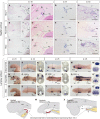Thyroid and endostyle development in cyclostomes provides new insights into the evolutionary history of vertebrates
- PMID: 35361194
- PMCID: PMC8973611
- DOI: 10.1186/s12915-022-01282-7
Thyroid and endostyle development in cyclostomes provides new insights into the evolutionary history of vertebrates
Abstract
Background: The endostyle is an epithelial exocrine gland found in non-vertebrate chordates (amphioxi and tunicates) and the larvae of modern lampreys. It is generally considered to be an evolutionary precursor of the thyroid gland of vertebrates. Transformation of the endostyle into the thyroid gland during the metamorphosis of lampreys is thus deemed to be a recapitulation of a past event in vertebrate evolution. In 1906, Stockard reported that the thyroid gland in hagfish, the sister cyclostome group of lampreys, develops through an endostyle-like primordium, strongly supporting the plesiomorphy of the lamprey endostyle. However, the findings in hagfish thyroid development were solely based on this single study, and these have not been confirmed by modern molecular, genetic, and morphological data pertaining to hagfish thyroid development over the last century.
Results: Here, we showed that the thyroid gland of hagfish undergoes direct development from the ventrorostral pharyngeal endoderm, where the previously described endostyle-like primordium was not found. The developmental pattern of the hagfish thyroid, including histological features and regulatory gene expression profiles, closely resembles that found in modern jawed vertebrates (gnathostomes). Meanwhile, as opposed to gnathostomes but similar to non-vertebrate chordates, lamprey and hagfish share a broad expression domain of Nkx2-1/2-4, a key regulatory gene, in the pharyngeal epithelium during early developmental stages.
Conclusions: Based on the direct development of the thyroid gland both in hagfish and gnathostomes, and the shared expression profile of thyroid-related transcription factors in the cyclostomes, we challenge the plesiomorphic status of the lamprey endostyle and propose an alternative hypothesis where the lamprey endostyle could be obtained secondarily in crown lampreys.
Keywords: Atavism; Cyclostomes; Development; Endostyle; Evolution; Hagfish; Lamprey; Thyroid gland.
© 2022. The Author(s).
Conflict of interest statement
The authors declare that they have no competing interests.
Figures




Similar articles
-
Genome biology of the cyclostomes and insights into the evolutionary biology of vertebrate genomes.Integr Comp Biol. 2010 Jul;50(1):130-7. doi: 10.1093/icb/icq023. Epub 2010 Apr 19. Integr Comp Biol. 2010. PMID: 21558194 Free PMC article.
-
Inner ear development in cyclostomes and evolution of the vertebrate semicircular canals.Nature. 2019 Jan;565(7739):347-350. doi: 10.1038/s41586-018-0782-y. Epub 2018 Dec 5. Nature. 2019. PMID: 30518864
-
microRNAs reveal the interrelationships of hagfish, lampreys, and gnathostomes and the nature of the ancestral vertebrate.Proc Natl Acad Sci U S A. 2010 Nov 9;107(45):19379-83. doi: 10.1073/pnas.1010350107. Epub 2010 Oct 19. Proc Natl Acad Sci U S A. 2010. PMID: 20959416 Free PMC article.
-
Evolution of the Vertebrate Cranium: Viewed from Hagfish Developmental Studies.Zoolog Sci. 2016 Jun;33(3):229-38. doi: 10.2108/zs150187. Zoolog Sci. 2016. PMID: 27268976 Review.
-
Reconstructing the ancestral vertebrate brain.Dev Growth Differ. 2017 May;59(4):163-174. doi: 10.1111/dgd.12347. Epub 2017 Apr 26. Dev Growth Differ. 2017. PMID: 28447337 Review.
Cited by
-
Comparative 3D-anatomy of Appendicularian Endostyles (Tunicata, Chordata) - A Tale of Reduction.J Morphol. 2025 Jul;286(7):e70061. doi: 10.1002/jmor.70061. J Morphol. 2025. PMID: 40580022 Free PMC article.
-
Differentiation of endostyle cells by Nkx2-1 and FoxE in the ascidian Ciona intestinalis type A: insights into shared gene regulation in glandular- and thyroid-equivalent elements of the chordate endostyle.Cell Tissue Res. 2022 Nov;390(2):189-205. doi: 10.1007/s00441-022-03679-w. Epub 2022 Sep 1. Cell Tissue Res. 2022. PMID: 36048302
-
Acquisition of neural crest promoted thyroid evolution from chordate endostyle.Sci Adv. 2025 Aug 8;11(32):eadv2657. doi: 10.1126/sciadv.adv2657. Epub 2025 Aug 6. Sci Adv. 2025. PMID: 40768591 Free PMC article.
-
Tumor Cell Plasticity and Stromal Microenvironment Distinguish Papillary and Follicular Growth Patterns in a Mouse Model of BRAFV600E-Induced Thyroid Cancer.Cancer Res Commun. 2025 Mar 1;5(3):409-421. doi: 10.1158/2767-9764.CRC-24-0474. Cancer Res Commun. 2025. PMID: 39956582 Free PMC article.
-
Transcriptional Analysis of the Endostyle Reveals Pharyngeal Organ Functions in Ascidian.Biology (Basel). 2023 Feb 3;12(2):245. doi: 10.3390/biology12020245. Biology (Basel). 2023. PMID: 36829522 Free PMC article.
References
-
- Ogasawara M, Shigetani Y, Suzuki S, Kuratani S, Satoh N. Expression of thyroid transcription factor-1 (TTF-1) gene in the ventral forebrain and endostyle of the agnathan vertebrate, Lampetra japonica. Genesis. 2001;30:51–58. - PubMed
-
- Kluge B, Renault N, Rohr KB. Anatomical and molecular reinvestigation of lamprey endostyle development provides new insight into thyroid gland evolution. Dev Genes Evol. 2005;215:32–40. - PubMed
-
- Norris D, Carr J. Vertebrate endocrinology. 5. New York: Academic; 2013.
-
- Matsumoto A, Ishii S. Atlas of endocrine organs: vertebrates and invertebrates. Berlin: Springer-Verlag; 1992.
-
- Baker KF, Berg O, Gorbman A, Nigrelli RF, Gordon M. Functional thyroid tumors in the kidneys of platyfish. Cancer Res. 1955;15:118–123. - PubMed
Publication types
MeSH terms
LinkOut - more resources
Full Text Sources
Miscellaneous

